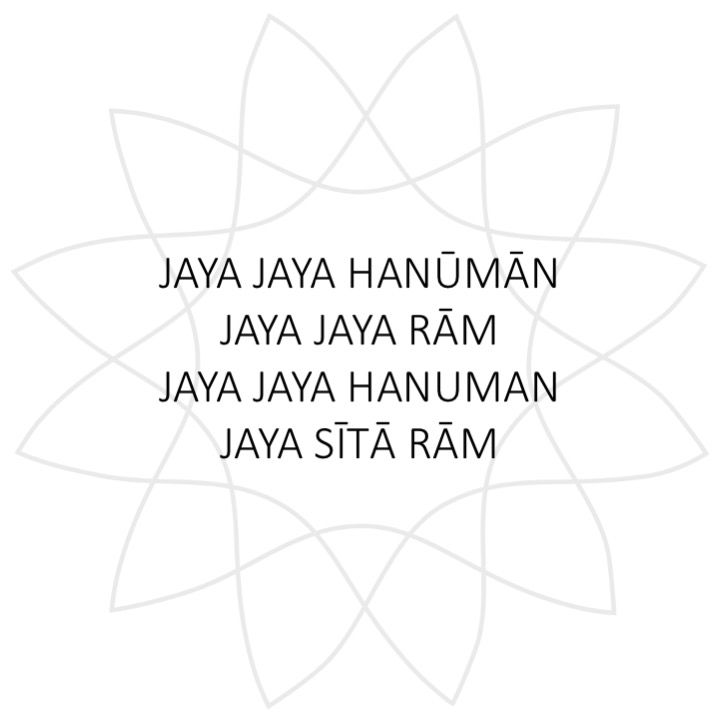JAYA JAYA HANŪMĀN JAYA JAYA RĀM
JAYA JAYA HANŪMĀN JAYA SĪTĀ RĀM
HARE RĀM HARE RĀM RĀMA RĀMA RĀM HARE
ŚRĪ RĀM JAI RĀM JAI JAI RĀM
Victory to Hanūmān, victory to Rāma
Victory to Hanūmān, victory to Sītā and Rāma
Viṣṇu, Rāma, Viṣṇu, Rāma, …
Glorious Rāma, praise Rāma, victory to Rāma
jaya: conquest, victory, triumph
hanūmān: the monkey king, and son of Vāyu, the wind god
rāma: incarnation of Viṣṇu, the preserver of the universe, literally “the ever blissful one”
sītā: incarnation of Lakṣmī, goddess of abundance and prosperity
hare: vocative form of hari, meaning “the remover”, referring to Viṣṇu as the remover of sorrows of the world
śrī: magnificent, splendid
In the epic Rāmāyaṇa, Hanūmān plays a major role in reuniting Sītā and Rāma after Sītā’s abduction by the demon king Rāvana. He is therefore known as a loyal and faithful friend and represents service and devotion. In the Tantric tradition, Hanuman is seen as the perfect Tantric who has acquired all eight mystical powers (aṣṭa siddhi-s), many of which came in handy on his mission to rescue Sītā:
1. Aṇimā (atomization): the ability to reduce oneself to the size one desires
2. Laghimā (levitation): the ability to make oneself almost weightless
3. Mahimā (magnification): the ability to make oneself as large as one desires
4. Prāpti (extension): the ability to reach for anything one desires
5. Prākāmya (will): the ability to exert one’s will power without obstruction
6. Vaśitva (mastery): the ability to control the elements
7. Īśitṛtva (lordship): the ability to manipulate all physical objects
8. Yatra-kāmāvasāyitva: the ability to fulfill all one’s desires
Even though we may not have superhuman powers like Hanūmān, just like Hanūmān we are capable of accomplishing extraordinary things, even though we may forget our abilities and inherent divinity.
In the studio recording of this mantra, I included a Hindi bhajan that was popularized by Mahatma Gandhi. It was sung by Gandhi and his followers during the twenty four day nonviolent civil disobedience march from Sabarmati Ashram to Dandi, which took place in 1930 to protest the British salt tax in India and became known as the Salt March or Dandi March. A beautiful version of this bhajan recorded by Ravi Shankar can be heard over the end titles of the 1982 movie “Gandhi”:
raghupati rāghav rājārām
patit pāvan sītārām
sītārām jai sītārām
bhaj pyāre tu sītārām
īśvar allāh tero nām
sab ko sanmati de bhagavān
Great king Rāma of the house of Raghu
Uplifter of the fallen and Rāma
Sītā and Rāma Sītā and Rāma
Oh beloved praise Sītā and Rāma
Īśvara or Allah whichever name we call you
May God bless everyone
CHORDS
Part 1
II:G I C :II
JAYA I JAYA HANŪMĀN JAYA I JAYA RĀM I
JAYA I JAYA HANŪMĀN JAYA I SĪTĀ RĀM I
Part 2
II:G I C :II
HARE I RĀM HARE RĀM RĀMA I RĀMA RĀM HA I RE
HARE I RĀM HARE RĀM RĀMA I RĀMA RĀM HA I RE
Part 3
II: G I C :II
II: ŚRĪ RĀM JAI RĀM I JAI JAI RĀM :II

